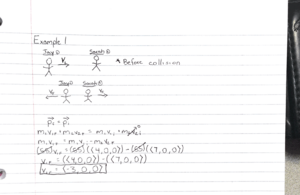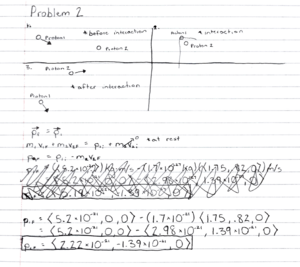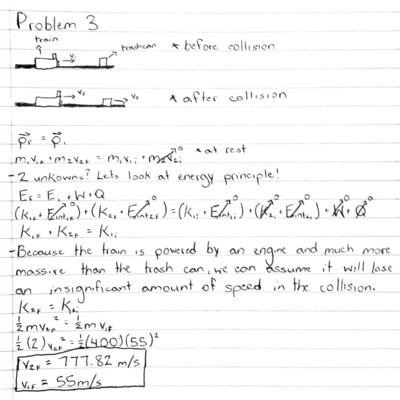Elastic Collisions: Difference between revisions
| Line 3: | Line 3: | ||
So what exactly is an elastic collision? You may be thinking of bubble gum or rubber bands, but "elastic" actually refers to the change in internal energy in the collision. An elastic collision does not have any change in the internal energy of the bodies involved. | So what exactly is an elastic collision? You may be thinking of bubble gum or rubber bands, but "elastic" actually refers to the change in internal energy in the collision. An elastic collision does not have any change in the internal energy of the bodies involved. | ||
First, we need to define a collision. A collision is an event/process in which two objects interact strongly for a short amount of time and in which there was very little interaction before they interacted and after the interaction. An elastic collision is a collision between two or more objects in which there is no loss in kinetic energy before and after the collision. If we assume that the colliding objects are part of the system and that there is no force from the surroundings, the final kinetic energy is still in the same form as it was initially. This is because the surrounding forces are considered to have a negligible impact compared to the forces that occur between the colliding objects. To keep it simple, this means that kinetic energy in = kinetic energy out. Usually, you can determine if a collision is elastic or not by seeing if the objects bounce off one another, which is not the case in inelastic collisions. To find the difference between the two types of collisions, keep in mind that momentum is transferred in both collisions, which means that the best way of differentiating would be to look at the transfer of kinetic energy. If the difference of internal and kinetic energy is equal to zero, then the collision is elastic. Apart from looking to see if the objects bounce off another or not, we can also judge by looking to see if the objects get deformed, are hotter, have more vibration/rotation or are in an excited state after collision. If any of the above happens, the collision is '''not''' elastic. | First, we need to define a collision. A collision is an event/process in which two objects interact strongly for a short amount of time and in which there was very little interaction before they interacted and after the interaction. An elastic collision is a collision between two or more objects in which there is no loss in kinetic energy before and after the collision. If we assume that the colliding objects are part of the system and that there is no force from the surroundings, the final kinetic energy is still in the same form as it was initially. This is because the surrounding forces are considered to have a negligible impact compared to the forces that occur between the colliding objects. To keep it simple, this means that kinetic energy in = kinetic energy out. Usually, you can determine if a collision is elastic or not by seeing if the objects bounce off one another, which is not the case in inelastic collisions. To find the difference between the two types of collisions, keep in mind that momentum is transferred in both collisions, which means that the best way of differentiating would be to look at the transfer of kinetic energy. If the difference of internal and kinetic energy is equal to zero, then the collision is elastic. Apart from looking to see if the objects bounce off another or not, we can also judge by looking to see if the objects get deformed, are hotter, have more vibration/rotation or are in an excited state after collision. If any of the above happens, the collision is '''not''' elastic. We know the collision is not elastic because some kinetic energy must be transferred to another form evidenced by one of the listed changes. For example, if the objects are deformed, some energy is lost or "used" to deform the objects, and the initial and final kinetic energies are therefore not the same. | ||
[[File:Elastischer_stoß2.gif|350px|thumb|right]] | [[File:Elastischer_stoß2.gif|350px|thumb|right]] | ||
Revision as of 15:21, 28 May 2019
The Main Idea
So what exactly is an elastic collision? You may be thinking of bubble gum or rubber bands, but "elastic" actually refers to the change in internal energy in the collision. An elastic collision does not have any change in the internal energy of the bodies involved.
First, we need to define a collision. A collision is an event/process in which two objects interact strongly for a short amount of time and in which there was very little interaction before they interacted and after the interaction. An elastic collision is a collision between two or more objects in which there is no loss in kinetic energy before and after the collision. If we assume that the colliding objects are part of the system and that there is no force from the surroundings, the final kinetic energy is still in the same form as it was initially. This is because the surrounding forces are considered to have a negligible impact compared to the forces that occur between the colliding objects. To keep it simple, this means that kinetic energy in = kinetic energy out. Usually, you can determine if a collision is elastic or not by seeing if the objects bounce off one another, which is not the case in inelastic collisions. To find the difference between the two types of collisions, keep in mind that momentum is transferred in both collisions, which means that the best way of differentiating would be to look at the transfer of kinetic energy. If the difference of internal and kinetic energy is equal to zero, then the collision is elastic. Apart from looking to see if the objects bounce off another or not, we can also judge by looking to see if the objects get deformed, are hotter, have more vibration/rotation or are in an excited state after collision. If any of the above happens, the collision is not elastic. We know the collision is not elastic because some kinetic energy must be transferred to another form evidenced by one of the listed changes. For example, if the objects are deformed, some energy is lost or "used" to deform the objects, and the initial and final kinetic energies are therefore not the same.

Additionally, elastic collisions are a wonderful representation of the conservation of momentum which states that the momentum of an isolated system is constant. For an isolated system undergoing an elastic collision momentum in = momentum out.
Pool is a great real-world example of elastic collisions. The game provides a great way to observe close to ideal elastic collision conditions in everyday life.
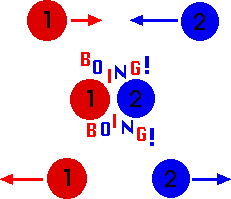
It's important to note that with macroscopic systems there are no perfectly elastic collisions because there's always some dissipation (for example thermal energy emitted), but most are nearly elastic. The only time there are perfect collisions is on a microscopic level when atomic systems with quantized energy collide, but that's only if there is enough energy available to raise the systems to an excited quantum state—but quantum energy is really a whole other topic. Let's focus on elastic collisions!
Here's a video walkthrough of a basic elastic collision: https://www.youtube.com/watch?v=V4vzNk4qppw
A Mathematical Model
Now lets take what we know about elastic collisions and talk about it in mathematical terms. There are three main mathematical concepts surrounding elastic collisions:
1. [math]\displaystyle{ K_f = K_i }[/math]
2. [math]\displaystyle{ \Delta E_{int} = 0 }[/math]
[math]\displaystyle{ \Delta E_{sys} + \Delta E_{surr} = 0 \\ }[/math] [math]\displaystyle{ \Delta E_{surr} = 0 }[/math] , so [math]\displaystyle{ \Delta E_{sys} = 0 }[/math] [math]\displaystyle{ E_{final} = E_{initial} \\ }[/math]
3. [math]\displaystyle{ \vec{p}_f = \vec{p}_i }[/math]
[math]\displaystyle{ \Delta \vec{p}_{sys} + \Delta \vec{p}_{surr} = 0 \\ }[/math] [math]\displaystyle{ \Delta \vec{p}_{surr} = 0 }[/math] , so [math]\displaystyle{ \Delta \vec{p}_{sys} = 0 }[/math] [math]\displaystyle{ \vec{p}_{final} = \vec{p}_{initial} \\ }[/math]
Example Problem
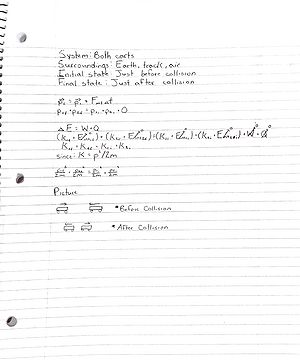
Cart 1, moving in the positive x direction, collides with cart 2 moving in the negative x direction. Both carts have identical masses and the collisions is (nearly) elastic, as it would be if the carts interacted magnetically or repelled each other through soft springs. What are the final momenta of the two carts?
1. After choosing a correct system, surroundings, and initial and final states, we can apply the momentum principle mentioned above to get a relationship between the initial and final momentums of the two carts. Usually, when we want to consider the system, we will consider the two colliding objects as the system and the rest as the surroundings. The initial state would be before the collision, and the final state would be after.
Momentum Principle: [math]\displaystyle{ \vec{p}_{final} = \vec{p}_{initial} + \vec{F}_{net}\Delta t }[/math]
And it turns into: [math]\displaystyle{ \vec{p}_{1f} + \vec{p}_{2f} = \vec{p}_{1i} + \vec{p}_{1f} }[/math] since during the collision, the [math]\displaystyle{ F_{net} }[/math] is negligible.
2. Next, by applying the energy principle we can gain knowledge about the final and initial kinetic energies. By acknowledging the fact that the change in internal energy is 0 and the fact the reaction happens so quickly that not work or heat transfer is done by the surroundings, the equation can be simplified to include just initial and final kinetic energies.
The Energy Principle: [math]\displaystyle{ \Delta E_{sys} = W + Q }[/math]
We then get rid of the work, heat transfer and internal energies:
[math]\displaystyle{ K_{1f} + \Delta E_{1int} + K_{2f} + \Delta E_{2int} = K_{1i} + K_{2i} + W + Q \\ }[/math] [math]\displaystyle{ \Delta E_{1int} = \Delta E_{2int} = W = Q = 0 \\ }[/math] [math]\displaystyle{ K_{1f} + K_{2f} = K_{1i} + K_{2i} }[/math]
The reason the internal energies are directly crossed out is because we can put them to one side since [math]\displaystyle{ E_{final} = E_{initial} }[/math] and therefore [math]\displaystyle{ E_{final} -
E_{initial} = 0 }[/math].
3. Once we have simplified the momentum and energy principles, one can use the relationship between kinetic energy and momentum mentioned above to get a relationship involving both energy and momentum. Once this is obtained, the equation can be shifted around to get both the final momentums.
Kinetic Energy Definition: [math]\displaystyle{ K = \frac{p^2}{2m} }[/math]
Finished Result: [math]\displaystyle{ \frac{p^2_{1f}}{2m} + \frac{p^2_{2f}}{2m} = \frac{p^2_{1i}}{2m} + \frac{p^2_{2i}}{2m} }[/math]
A Mathematical Model
There is another (easier) method of solving problems involving elastic collisions. This involves the use of the center of mass velocity, which can be calculated as [math]\displaystyle{ v_{COM} = \frac{m_{1}v_{1,i}+m_{2}v_{2,i}}{m_{1}+m_{2}} }[/math]. The elastic collision formula is [math]\displaystyle{ |v_{1,i}-v_{COM}| = |v_{1,f}-v_{COM}| }[/math].
Example Problem
Computational Models
The trinket model linked demonstrates an elastic collision between two spheres.
Elastic Collision Glowscript Model
The video below demonstrates a basic car crash elastic collision using MATLAB. Take note of the changes in displacement and the time.
Elastic Collision MATLAB model
Examples
Reminders
Be sure to show all steps in your solution and include diagrams whenever possible. For a lot of the complicated problems, starting with a diagram and writing down the given information and plugging that into either the momentum or energy principle can help you move forward in the problem. It would be helpful to also write the main principles at the side to remind yourself of how you found it. If you still get stuck, try finding similar examples to that problem and look at the solutions to get on the right track.
Simple
Let’s start with a simple example like the ones you don't see on the test.
Question
Jay and Sarah are best friends. Since they’re best friends they both weigh [math]\displaystyle{ 55 kg }[/math]. Jay hadn’t seen Sarah in a long time, so when she saw her she ran to her with a velocity of [math]\displaystyle{ \lt 4,0,0\gt m/s }[/math]. Instead of a hug, they were both too excited and collided and bounced back off of each other, and Sarah flew back with a velocity of [math]\displaystyle{ \lt 7,0,0\gt m/s }[/math]. What was Jay’s final velocity?
Solution
In a lot of simple elastic collision problems, the momentum principle is all you need to solve them. Most problems will give you the initial velocities, masses, and one final velocity and you will be asked to solve for a either a final velocity or final momentum. By setting up an equation like the one in this problem, one can easily handle this type of problem.
Middling
Question
When far apart, the momentum of a proton is [math]\displaystyle{ \lt 5.2 * 10^{−21}, 0, 0\gt kg · m/s }[/math] as it approaches another proton that is initially at rest. The two protons repel each other electrically, but they are not close enough to touch. When they are far apart again later, one of the protons now has a velocity of [math]\displaystyle{ \lt 1.75, .82, 0\gt m/s }[/math]. At that instant, what is the momentum of the other proton? HINT: The mass of a proton is [math]\displaystyle{ 1.7 *10^{-21} kg }[/math].
Solution
A lot of people freak out when they see problems involving atomic particles and electrical forces, but the concept is the same no matter the scale. For this problem we are given masses, velocities, and momentum, but the equation [math]\displaystyle{ p = mv }[/math] allows us to easily handle these different values. Once again drawing a diagram helps to understand what is actually happening in the problem, making it easier to put the values in the correct places and solve.
Difficult
Okay, let's get a little bit trickier here...
Question
There is a [math]\displaystyle{ 400 kg }[/math] train traveling at [math]\displaystyle{ 55 m/s }[/math] that collides, elastically of course, with a random [math]\displaystyle{ 2 kg }[/math] trashcan that's stationary on the tracks. Afterwards, what are the speeds of both the train and the trashcan after the collision?
Solution
This was a difficult problem because of the assumptions we had to make in order to solve it. Because the collision was elastic we were able to disregard the change in internal energy in the energy principle, and since it happened so quickly the work done by the track and heat transfer between the surroundings was negligible. It is tough to tell what assumptions you can make and which ones you can't in problems like these, which is what can make them difficult. On most exams or quizzes the collision problems will be inelastic simply because they are harder, but it is important to understand the fundamentals of elastic collisions and how to solve problems involving them.
Connectedness
So how are collisions connected to the real world? Collisions are all around us!
One main example is cars. Lots of car companies will purposely test and wreck cars to test collisions! Data is then sent to places like the Insurance Institute for Highway Safety where we can learn about car agility and more.
Another example of collisions in real life is billiards. This is one of the most accurate real life examples of elastic collisions. One ball hits another ball at rest, and if done right the first ball stops and transfers nearly all its kinetic energy into kinetic energy in the second ball. We consider this a head on collision of equal masses.
A third example is hitting a baseball. Hitting a ball off the end or to close the hands of a bat will cause some vibrational energy from the collision, but if the ball catches the sweet spot the collision is very elastic, and you don't feel any vibration when you strike the ball.
Elastic collisions also happen between particles. The Rutherford Scattering experiment mentioned below is a good example.
History
Collisions are certainly not a new concept in the world. Ever since the beginning of time things have been colliding and reacting in different ways. It was experiments done by scientists like Newton and Rutherford that started to characterize collisions into categories and apply fundamental principles of physics to the reactions. What we observed above was the Newtonian way.
The history of collisions originates from the Rutherford Scattering experiment. It consisted of shooting alpha particles through a thin gold foil. As Rutherford studied the scattering of alpha particles through metal foils, he first noticed a collision with a single massive positive particle. Although the alpha particles did not hit the nucleus of the gold atoms, they did interact with each other and therefore can be considered as a collision. Since the interaction did not excite the gold atoms, fortunately enough, it was an elastic collision. This lead to the conclusion that the positive charge of the mass was concentrated in the center, the atomic nucleus! The plum pudding model (where the positive and negative charges were stuck within the atom like plums in a pudding), that had been around was disproved. When further research was done, they measured the angle of the 'scattering' or the particles shot through a tin gold foil. Had the collisions been inelastic, the particles would not have been able to bounce back.
See also
Collisions for a general understanding of all collisions.
Inelastic Collisions to contrast them from elastic collisions.
Further reading
http://www.britannica.com/science/elastic-collision
External links
Different Types of Elastic Collisions
References
Main Idea:
Matter and Interactions, 4th Edition
http://www.sparknotes.com/testprep/books/sat2/physics/chapter9section4.rhtml
http://blogs.bu.edu/ggarber/archive/bua-physics/collisions-and-conservation-of-momentum/
History:
Matter and Interactions, 4th Edition
https://en.wikipedia.org/wiki/Elastic_collision
https://www.youtube.com/watch?v=5pZj0u_XMbc
Connectedness:
Additionally used references from see also.

